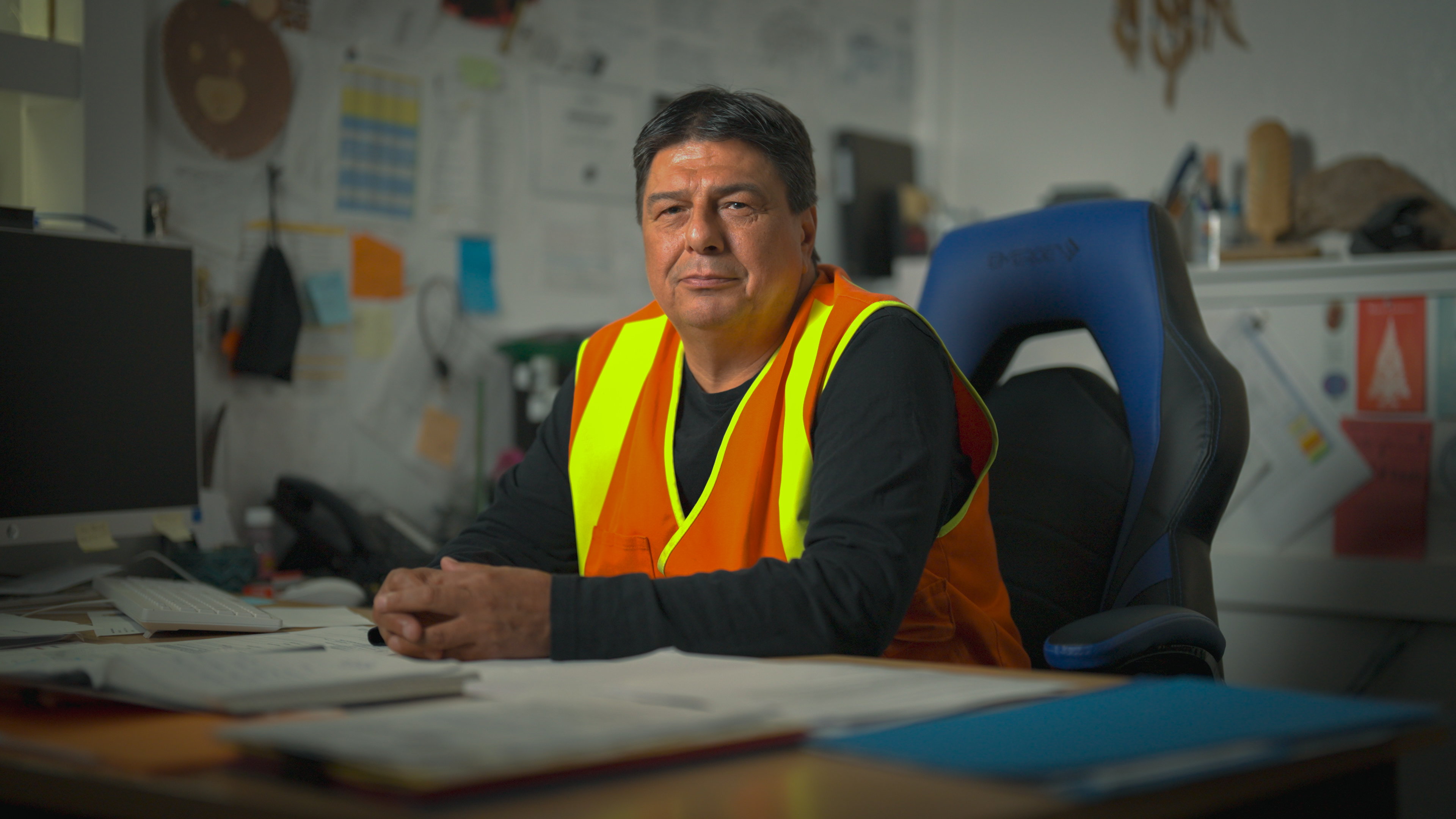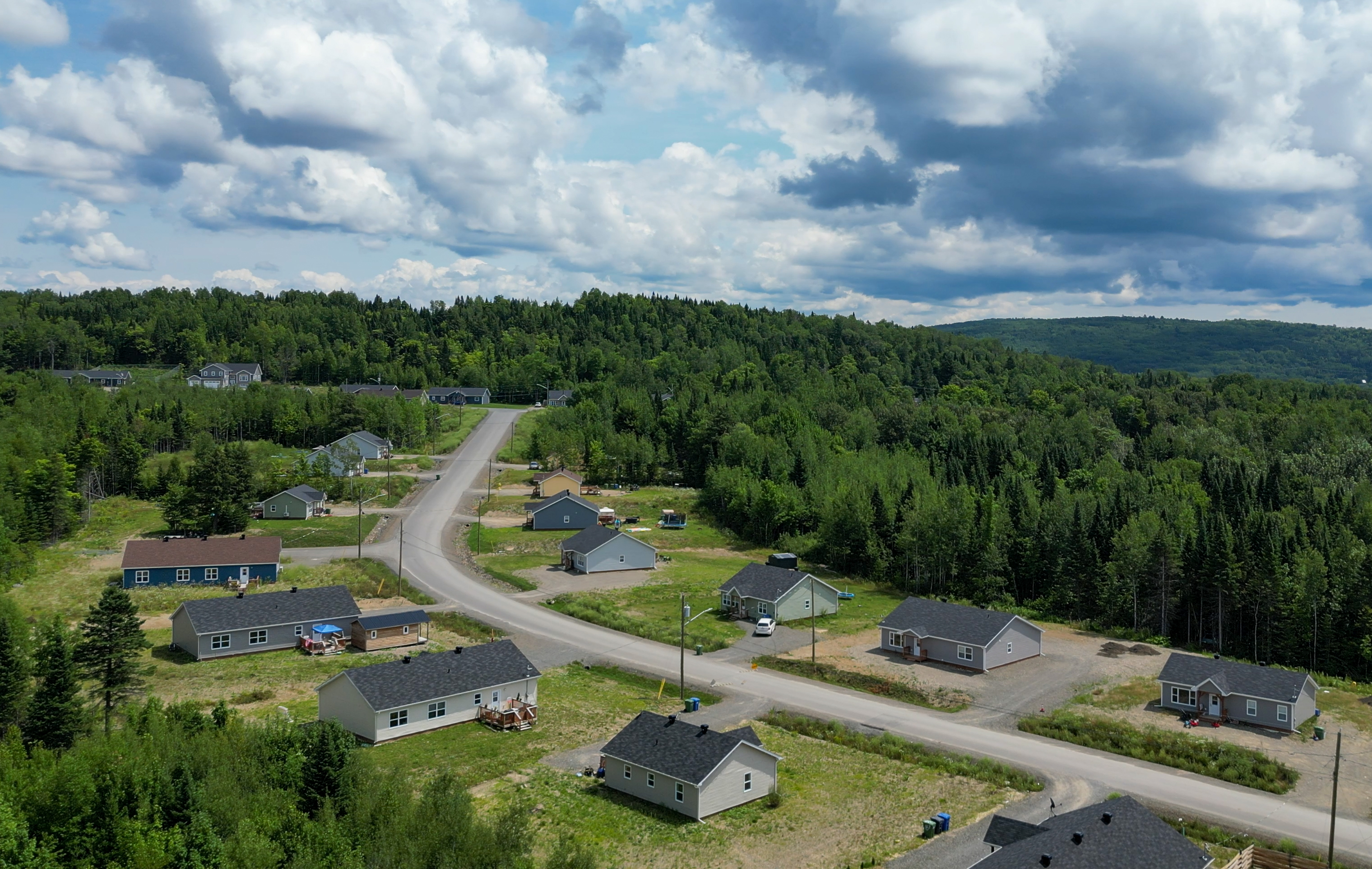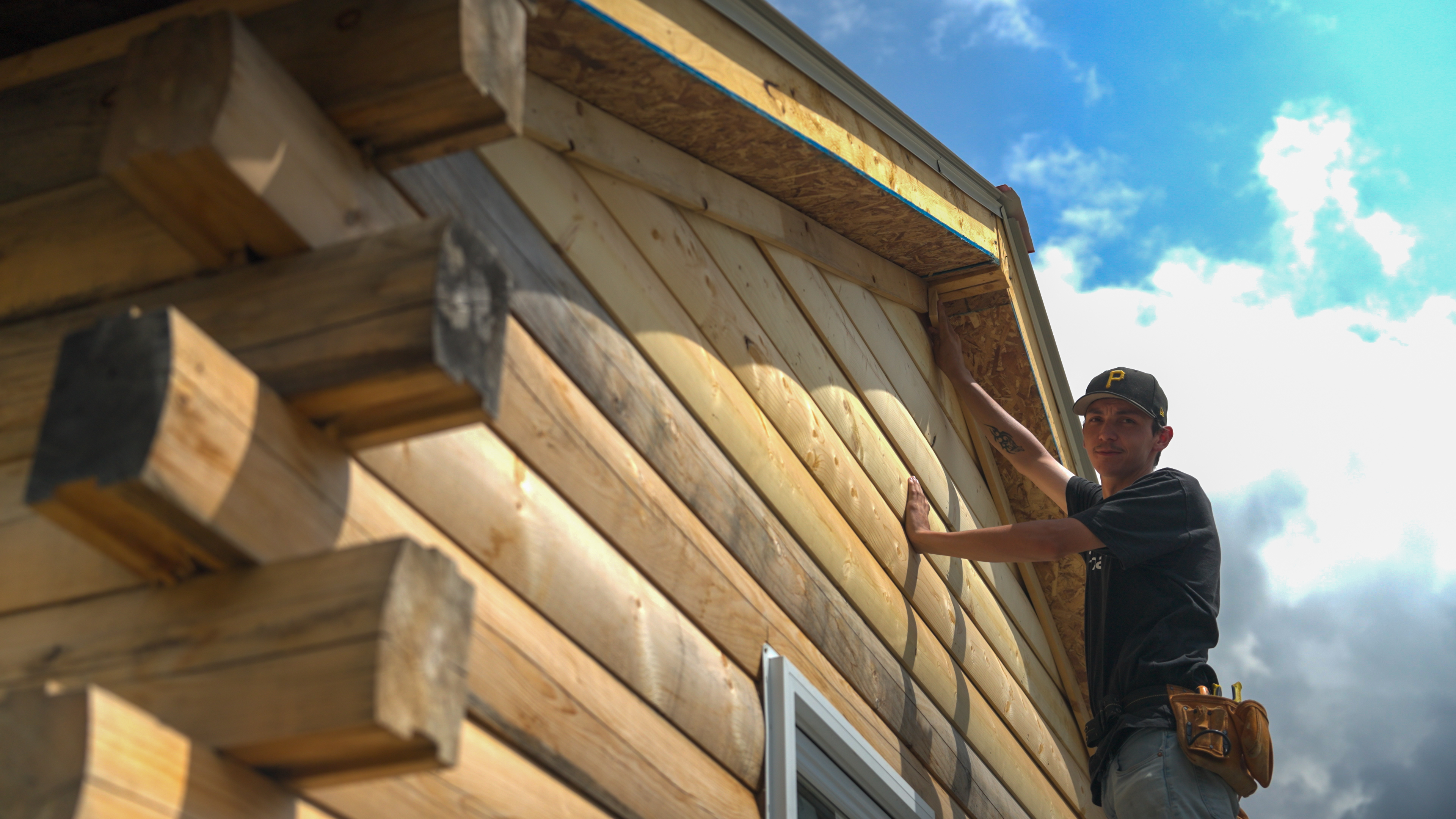Community’s future leaders build for tomorrow
October 25, 2024
(Visual: A bird’s-eye view of a bridge over the Tobique River. The camera cuts to a car passing in front of the Kulasihkulpon welcome sign. The camera cuts to a close-up of a wooden house.)
00:00:05
KEN MOULTON: Tobique is a Maliseet First Nation, currently located between the Tobique River and the St. John River, sometimes referred to as the Point. Our on-reserve population is around 2,200, and I want to say around 50% of that is an age category between the ages of 18 and 27.
(Text on screen: “People of the beautiful river. Where two rivers meet”)
(Visual: The camera cuts to a woman cutting wicker ribbon. The camera cuts to two women handcrafting objects with wicker ribbon. The camera cuts to a small First Nation house.)
00:00:32
KEN: Right now, Tobique has a housing backlog of around 250 applications. That's single and parents and family-oriented, some elders in there. So, there's a backlog there. Over the last five years, we've done 60+ homes and probably two and a half kilometres of new roads and infrastructure to support our growing housing needs.
(Text on screen: “A place to gather”)
(Visual: The camera cuts to a car leaving a warehouse. The camera cuts to a man entering the warehouse. The camera cuts to the man, Ken Moulton, speaking at his desk.)
(Text on screen: Ken Moulton, Director – TFN Public Works/Housing)
(Visual: The camera cuts to a close-up of a framed photo of an old man. The camera cuts to a close-up of Ken Moulton working on his computer. The camera cuts to a close-up of architectural plans browsed by Ken Moulton. The camera cuts to a close-up of a satellite picture of Wolastoqiyik Neqotkuk – Kulasihkulpon, pointed at with a wood stick. The picture shows many notes and highlighted streets. The camera cuts to a close-up of Ken’s hand using his computer’s mouse. The camera cuts to Ken speaking. The camera cuts to a close-up of Ken’s hands typing on a keyboard.)
00:01:13
KEN: Some of the challenges that we have with such a young demographic is a lot of them have put themselves already in family situations and are unable to either finish school or finish trade school. So, it makes it hard for us to draw from the educational pool, for example. So, we try to do our best to create in-house training programs to help people stay within the community, support their family and not have to go away to create a living.
(Visual: The camera cuts to a close-up of framed photos. The camera cuts to Ken speaking. The camera cuts to Ken leaving the warehouse. The camera cuts to Ken getting into his pickup. The camera cuts to a bird’s-eye view of a street with small houses and forest.)
00:01:46
KEN: The CMHC Internship, the HIIFNIY, has been a great asset for me to introduce plumbing, electrical, carpentry to some of the younger boys and girls who haven't finished school and haven't had any introduction to any of the trades or any of the technical schools.
(Visual: The camera cuts to houses being built. The camera cuts to different views of construction workers. The camera cuts to a man measuring wood, then cutting wood.)
00:02:06
KEN: You know the old adage, right? You teach somebody how to fish, you feed them for life, right? So, it's similar here. I'm giving them a chance at a career to stay within the community and help grow their family.
(Visual: The camera cuts to views of Dawson using a power drill on the house being built. The camera cuts to a close-up of Thentenhawitha Bear. The camera cuts to views of Thentenhawitha handing tools to another worker.)
(Text on screen: Thentenhawitha Bear, Intern – Housing Internship for Indigenous Youth (HIIY))
00:02:23
THENTENHAWITHA BEAR: My name is Thentenhawitha Bear. I'm 17, and I'm part of the Housing Internship Program. The main reason I wanted to do electrical is because I wanted to figure out how I was going to support my little family. So, I got my son back at home, and I wanted to make a quick decision. I've been really enjoying just everything. I'm taking it all in. I'm trying to learn as much as I can.
(Visual: The camera cuts to Thentenhawitha speaking.)
00:02:46
D’ARTAGNON PERLEY: I'm D'artagnon Perley. I'm 24. I'm a Red Seal electrician, and I'm a graduate of the Program. I really didn't have any plans. I did odd carpentry jobs for my cousins, my uncles, and pumped gas. I realized I could work all day doing that and not get ahead any. So going into the trades was really a no-brainer.
(Visual: The camera cuts to a close-up of D'artagnon winking. The camera cuts to D'artagnon working on electrical wire on the house roof. The camera cuts to a close-up of D'artagnon speaking.)
(Text on screen: D'artagnon Perley, Alumni – Housing Internship for Indigenous Youth (HIIY))
(Visual: The camera cuts to a close-up of D'artagnon cutting electrical wire.)
00:03:10
DAWSON SAPPIER: I'm Dawson, I'm 25 and I'm part of the Housing Internship Program. Most of the people I work with, I grew up with, and I have a good friendship with them, and we work good together, and we bounce ideas off each other all the time and stuff like that and it really helps a lot. Anything you need, they're always there for you anytime.
(Visual: The camera cuts to a close-up of Dawson. The camera cuts to Dawson handling a piece of wood. The camera cuts to Dawson speaking.)
(Text on screen: Dawson Sappier, Intern – Housing Internship for Indigenous Youth (HIIY))
(Visual: The camera cuts to a close-up a someone writing by hand on wood. The camera cuts to a view of three men.)
00:03:40
KEN: Some of the types of skills that we hope that our interns are able to take away from the program are general life skills, working in team settings, introduction into some of the various hand tools. We do a first-aid course with everybody. And then it's just a brief introduction into the electrical, the plumbing, the carpentry. So, it gives them a touch upon everything to see where they really want to hone in and create a career from.
(Visual: The camera cuts to Dawson walking into the house being built. The camera cuts to a bird’s-eye view of the streets on which new houses have been built. The camera cuts to a close-up of a house roof, then cuts to a view of the ground and porch. The camera cuts to the reflection of an excavator on a house window. The camera cuts to a view of a house being built with many construction workers around it. The camera cuts to a brand-new house. The camera cuts to a bird’s-eye view of a street with houses being built, in different construction phases.)
00:04:09
D’ARTAGNON: It's very satisfying. It gives me a sense of purpose. Being able to stand at the end of the road and seeing all the houses that I've worked in. It gave me an essence of purpose, I guess.
(Visual: The camera cuts to a bird’s-eye view of brand-new houses. The camera cuts to a close-up of wood planks, then changes focus to the new house behind it. The camera cuts to D'artagnon and Thentenhawitha working together. The camera cuts to D'artagnon speaking. The camera cuts to D'artagnon working with electrical wires on the house’s roof.)
00:04:24
DAWSON: Everything I do every day is something I enjoy doing. And being in this program now really helps me to be able to do that every day. Maybe in the future, I'd like to build my own home in the community and use all the skills that I've learned doing this program.
(Visual: The camera cuts to a large bird’s-eye view of the forest, street, houses and Tobique River. The camera cuts to a bird’s-eye view of a street with houses. The camera cuts to Dawson speaking. The camera cuts to Dawson cutting wood. The camera cuts to Dawson speaking. The camera cuts to Dawson removing his tool belt. The camera cuts to Dawson moving scaffolding.)
00:04:42
THENTENHAWITHA: This is just starting me off and getting me more motivated to become what I want to become, and especially help the community in a lot of ways. It made me look forward to the future. I can really be something. I can really do a lot for my family, and I can provide. And that's my main thing I want to do is provide for my son and my family.
(Visual: The camera cuts to Thentenhawitha speaking. The camera cuts to a man handing wires to Thentenhawitha. The camera cuts to a view of Ken. The camera cuts to a view of four men standing with crossed arms. The camera cuts to a view of Thentenhawitha and D'artagnon. The camera zooms in on a house being built. The camera cuts to a bird’s-eye view of the house being built, then zooms out. The camera cuts to the Kulasihkulpon welcome sign. The camera cuts to the CHMC SCHL logo on a white background.)
AT A GLANCE
- Tobique First Nation is the fastest growing Maliseet First Nation in New Brunswick.
- Approximately half of Tobique’s on-reserve population is between the ages of 18 and 27.
- As the community’s director of housing and public works, Ken Moulton is using CMHC’s Housing Internship for Indigenous Youth program to provide training opportunities for young people.
- The internship program is helping youth develop a career, stay within the community and shape its future.
Deep inside a warehouse of road signs, construction tools and machine-ready lumber lies Ken Moulton’s office. Tobique First Nation’s director of housing and public works doesn’t spend a lot of time here, however. He is constantly on the go, ensuring the next generation has an opportunity to live and work in the community he is proud to call home.

“That’s me as a young man, with my friends,” says Ken, pointing to a photo on the wall opposite his desk. Leaning to look behind him at a black and white portrait he adds, “And that’s my grandfather shortly before he passed.” To his left, a photo of his own family and beside that, a map of the community’s completed, current and future housing projects.
Tobique (Neqotkuk) is a Maliseet First Nation in New Brunswick located between the Tobique River and the Saint John River, sometimes referred to as The Point.
The on-reserve population is approximately 2,200, about half of which is aged between 18 and 27.
“Right now, Tobique has a housing backlog of around 250 applications,” says Ken. “That’s singles and parents and families or some elders in there.
Over the last 5 years, we’ve done 60 plus homes and probably 2 and a half kilometres of roads and infrastructure to support our growing housing needs. It’s government working with government working with government."

TRAINING THE NEXT GENERATION
Ken has made it a priority to create in-house training programs to help young people to stay within the community, support their family “…and not have to go away to create a living.”
One of his most successful tools to date is the Housing Internship for Indigenous Youth.
I want to let young people know, if you look hard at this and make it a career you can make a productive living for you and your family.
The program is offered by CMHC and provides financial assistance – a wage subsidy – to enable communities to hire Indigenous youth for internship positions.

“Some of the skills that we hope our interns are able to take away from the program are general life skills,” says Ken. “Working in team settings, introduction into some of the various hand tools. We do a first aid course with everybody. And then it’s just a brief introduction into the plumbing, the electrical, the carpentry so it gives them a touch upon everything to see where they really want to hone in and create a career from.”
Since 2018, Tobique has trained almost 30 interns. Many are now Red Seal carpenters, electricians and plumbers working in the community.
BUILDING THE FUTURE
It’s a warm summer day and Ken takes us on a tour. The children are away at camp and the swimming hole is quiet and serene. At the new subdivision Ken waves to his son working on a new road.
On Main Street we stop at the Paul Pyres Community Hall, the first project to be completed by housing interns.
“All the logs came from our mill and I believe the interns completed the building with the help of some of our seasoned carpenters,” says Ken. “We put it directly back into the community.”
Our final stop is a new log-frame building where several past and present interns are finishing up the exterior.
Seventeen-year-old Thentenhawitha (Tunda) started the program a few weeks ago.
“Main reason I wanted to do electrical is to figure out how I was gonna support my little family,” he says. “I got my son back at home and I wanted to make a quick decision and have something I enjoy.”
Tunda’s mentor is 24-year-old Red Seal electrician and program graduate D’artagnon.
It’s very satisfying, it gives me a sense of purpose, being able to stand at the end of the road and see all the houses that I’ve worked in.
After doing odd carpentry jobs for his cousins and pumping gas D’artagnon says going into the trades was a “no brainer.” He wanted steady work and saw that there was a need for electricians in the community.
Twenty-five-year-old Dawson is putting the last few screws on the building’s A-frame entrance.
“I like framing and putting it all together,” he says. “I’m a visual and hands-on learner…I just love doing it every day.”

PERSONAL GROWTH
In addition to developing trade skills, the interns are experiencing personal growth.
“I don’t like to take my time,” says Tunda. “I like to do it as fast as I can to impress…but I’m learning to be more patient with myself and staying humble.”
“I think it helped me with my social skills mostly,” says D’artagnon. “Doing service calls, getting in touch with the community. I’d go somewhere, something was wrong, I’d be able to fix it, and to me that’s just another day on the job but to the homeowner that was really something.”
I boost their ego all the time when they’re doing something well. It goes a long way.
Ken understands the power of positive feedback.
“I boost their ego all the time when they’re doing something well. It goes a long way.
I know when I was young, and my mentors were telling me that I was doing a wonderful job, it made it very encouraging to come back the next day knowing that I was doing my part and I was learning something.”

THE ROAD AHEAD
Reflecting on the future, Dawson may use his skills to build his own home, maybe by the river.
D’artagnon might start his own company.
This is just starting me off and getting me more motivated to become, what I want to become.
As the newest intern, Tunda says he’s taking it all in and trying to learn as much as he can.
“This is just starting me off and getting me more motivated to become, what I want to become,” he says. “And especially help the community. It made me look forward to the future. I can really be something, I can do a lot for my family. I can provide.”
KEY FACTS
- The Housing Internship for Indigenous Youth program is funded by the Government of Canada and delivered by CMHC in collaboration with Indigenous Services Canada.
- The Government of Canada’s Rapid Housing Initiative has supported the development of 12 new homes at Tobique First Nation.
- Support from the Government of Canada’s Affordable Housing Fund is facilitating repairs to 20 units at Tobique First Nation.
- The Government of Canada’s Housing Accelerator Fund is helping Tobique First Nation to improve the community’s housing systems and process. This includes exploring ways to increase density, improve data collection and empower housing staff to make faster decisions.






 Share via Email
Share via Email
